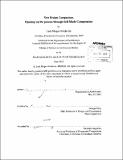New design companions opening up the process through self-made computation
Author(s)
Mogas-Soldevila, Laia
DownloadFull printable version (18.28Mb)
Other Contributors
Massachusetts Institute of Technology. Department of Architecture.
Advisor
George Stiny.
Terms of use
Metadata
Show full item recordAbstract
This thesis is about man and machine roles in the early conception of designs where it investigates computational methods that support creativity and surprise. It discusses the relationship between human and digital medium in the enterprise of Computer-Aided Design', and Self-Made Computation to empower the designer as driver of digital processes taking the computer as an active collaborator, or a sharp apprentice, rather than a master. In a design process tool personalization enables precise feedback between human and medium. In the field of architecture, every project is unique, and there are as many design workflows as designers. However current off-the-shelf design software has an inflexible built-in structure targeting general problem-solving that can interfere with non-standard design needs. Today, those with programming agility look for customized processes that assist early problem-finding instead of converging solutions. Contributing to alleviate software frustrations, smaller tailor-made applications prove to be precisely tailored, viable and enriching companions in certain moments of the project development. Previous work on the impact of standardized software for design has focused on the figure of the designer as a tool-user, this thesis addresses the question from the vision of the designer as a tool-maker. It investigates how self-made software can become a design companion for computational thinking - observed here as a new mindset that shifts design workflows, rather than a technique. The research compares and diagrams designer-toolmaker work where self-made applets where produced, as well as the structures in the work of rule-maker artisans. The main contributions are a comparative study of three models of computer-aided design, their history and technical review, their influence in design workflows and a graphical framework to better compare them. Critical analysis reveals a common structure to tailor a creative and explorative design workflow. Its advantages and limitations are exposed to guide designers into alternative computational methods for design processes. Keywords: design workflow; computation; applets; self-made tools; diagrams; design process; feedback; computers; computer-assisted-design
Description
Thesis (S.M.)--Massachusetts Institute of Technology, Dept. of Architecture, 2013. Cataloged from PDF version of thesis. Includes bibliographical references (p. 73-75).
Date issued
2013Department
Massachusetts Institute of Technology. Department of ArchitecturePublisher
Massachusetts Institute of Technology
Keywords
Architecture.